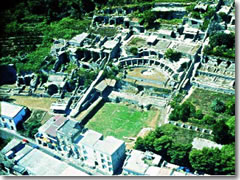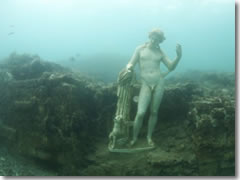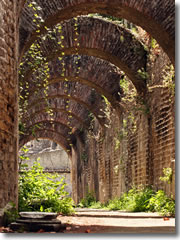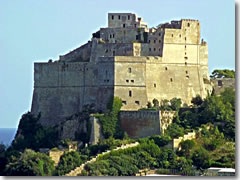- Places
- Plans
- Itineraries
- Experiences

The ruins at Baia are right downtownAll that volcanic activity around Pozzuoli and Solfatara sounds ominous, but it also makes for some great hot springs, lots of picturesque small lakes that gather in extinct craters, and remarkably fertile soil.
Such attractions contributed to the Phlegrean Fields becoming prime real estate during the ancient empire, the area where Emperors and other Roman bigwigs built their summer palaces.
Baia, named after Odysseus' navigator, was the Hamptons, Beverly Hills, or perhaps Palm Springs of the ancient world, the place where Caligula built a pleasure villa, Nero murdered his mother Agrippina, Cicero retreated to collect his oratorical thoughts and to entertain Caesar during Saturnalia feasts, and Hadrian passed away in AD 138.
Today Baia's a pleasant little town with several good archaeological sites and a museum of ancient statues in the late medieval castle.

A statue under the bay forms park of Baia's underwater archeological parkMuch of the ancient port is, due to earthquakes and bradyism, actually under the shallow waters of the bay just offshore.
This is now part of the Parco Sommerso di Baia Area Marina Protetta (Submerged Park of the Protected Baia Marina Area). For years these ruins were the provence of only a few intrepid archaeologists, but now tourists can visit the park to see some of its eerily preserved underwater mosaics, statues and Roman ruins.
You can visit the park in several ways: in a glass-bottomed boat, in a "Videobarca" (you ride out in a Zodiac-like rubber boat and a professional in scuba gear takes down a video camera to beam live images of what's below you back up to the boat), by snorkel, or even by scuba; for more info: tel. +39-081-868-8923, www.areamarinaprotettabaia.it.

The Terme di Baia, part of the baths complex amid the ruins of the Archeological Park in BaiaOther, more easily accessible ruins are scattered around town on dry land. There's even part of a baths complex just behind the train station erroneously called the Tempio di Diana.
The bulk of the remains are gathered together in the Archaeological Park (tel. +39-081-868-7592, cir.campania.beniculturali.it/archeobaia), a slope of terraced ruins whose crumbling brick walls and remnants of halls, domed roofs, and archways recall the rich series of temples, baths, and shops that filled the ancient Roman city from the AD 1st to 4th centuries.
The Baia archeological park is open Tuesday to Sunday 9am to an hour before sunset. There is, as of 2013, an admission fee, but since you have to get the ticket from the Baia Museum (below), entrance is actually free when that is closed.

The 16th century castle of Baia.At the edge of town, above the sea on the road toward Capo Misensio, rises the imposing 16th-century Castello di Baia.
Since 1993 it has been home to the Museo Archeologico dei Campi Flegrei (tel. +39-081-523-3797; cir.campania.beniculturali.it), with statuary and other finds from Baia and nearby excavations, including Roman-era plaster casts of Greek statues that were used as models for sculptors.
It's open Tuesday to Sunday 9am to 2:30pm (Adm).
Campi Flegrei Tourist Info:
Largo Matteotti 1A, Pozzuoli
tel. +39-081-526-6639
www.infocampiflegrei.it
or
www.coopculture.it
Take the the Cumana suburban rail line from Pozzuoli or the SEPSA bus from Cuma (tel. +39-081-551-3328, www.sepsa.it).
For tickets, you can get a Unico Napoli ticket for €3.10 that lasts all day and covers pretty much all of this region—or get the Artecard sightseeing pass, detailed below. (» more on getting around Campi Flegrei.)
There are two versions of the Campania sightseeing pass that covers this area: Napoli e Campi Flegrei (€16 for three days; 3 sights free, the rest half-off; and all public transport) and Archeologia del Golfo (€30 for 3 days; all sights—including all the ones here [except Solfatara], plus Pompeii, Herculaneum, the Naples Archaeological Museum, and more; and all public transport). Since the sights of the Campi Flegrei are all covered on a single, €4 ticket (again, except privately-run Solfatara), if you get that first pass I'd actually use the 3 freebies for pricier marquee sights in Naples—but you still get 50% off your Phlegrean Fields ticket, plus that invaluable free bus/Metro pass. For details: www.campaniartecard.it.
Share this page
Search ReidsItaly.com
Campania tourism information:
www.incampania.com